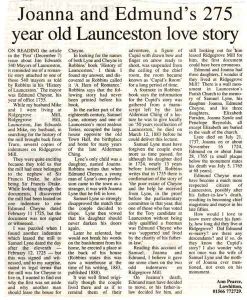An extract from Sir Alf Robbins book ‘Launceston Past and Present’ :
Edmund Cheyne, who here figures as chief magistrate of the town, was a hero of a love romance which, is believed, has not hitherto found its way into print. In the earlier years of the century (18th), Samuel Lyne, attorney, and one of the most zealous of Launceston Tories, occupied the large house opposite the old Town Hall (then in the square), which was the birthplace and for many years the residence of the late Alderman John Ching (the first captain of the Volunteer Fire Brigade). His only child was a daughter, and when Edmund Cheyne, a young man in his own profession, came to the town as a stranger it was with Joanna Lyne that he fell in love. The farther so strongly disapproved the match that an elopement followed, and Lyne vowed that his daughter should never darken his doors again. Later he relented, but, determined not to break his word, he erected at the back of his residence a place now used as a warehouse, but originally well fitted up. In this the young couple were lodged, and, as if to remind them of their adventure, there was suspended from the ceiling of the chief room a figure of Cupid, drawn-bow in hand and with finger on arrow ready to shoot. It may be taken that the builder of ‘Cupids room,’ as it long was called, more completely forgave the offence as time rolled on, for, although his daughter died in 1724, nearly thirteen years before himself, we find incidental confirmation of the story – of the poor estate of Cheyne and of the help he received from Lyne – in the proof before the Parliamentary Committee in 1735 that one of those who in the previous year had voted for the Tory candidates at Launceston without being duly qualified as a freeman was Edmund Cheyne, who ‘was supported and lived by the Charity of his Father-in-law.’

Extracted from Mr Ching’s “Reminiscences of Launceston” by Jim Edwards 2005.
“Connected with this room (Cupid’s Room it was always known by) was the handsome painting of Charles I, said to be by Vandyke, and for half a century placed on the walls of the Council Chamber, recently the property in fee simple of the Corporation of Launceston, and occupied by them for their meetings. This picture is on oak panels, and was used as a division to form a passage through Cupid’s Room to a small chamber built on the outer wall. When the premises were converted into mercantile uses, the larger room was used as a tea room for storing chests of tea, and the front of the picture was turned on the inside of the room and opposite the window – a large one – so that the painting must have been obscured with dirt and rough treatment when converted to so base a use. My father was in this room on one occasion, when he saw by a strong light on the partition something like the face of a man. His curiosity led him to get up, and with his pocket handkerchief and moisture he rubbed away the dirt, and found to his surprise the head of a cavalier on horseback. He took sponge and soap wherewith to cleanse the whole of the picture, and the result is the valuable painting now in the new Guildhall. Various surmises were made as to how the painting could have got into this position. One I remember, was that it was now safe to have any painting of the deposed Royal Family in one’s possession, and so this picture was hidden away in some obscure place, and may have been put up against the wall in this room, and there remained, those who knew of its existence having possibly passed away, or the property changed hands. All this is not easily explained, but the result was that my father offered the picture to the Mayor, and it was cleaned, the frame restored and regilded, and put up in the upper room of the then Council buildings. In my first Mayoralty – 1841-1842 – a picture cleaner came into the neighbourhood. He heard of this Vandyke, and came to ask me to be allowed to see it. After examination, he said it was undoubtedly a valuable picture, and he could get £300. for it. Of course it was not for sale, which perhaps he knew, or guessed as much. He gave “several days to cleaning it, and told me that he could not conceive how it could have been so terribly injured. He said there were hundreds of scratches on it, as if a nail had been used to deface it. I then told him the use it had been put to, and that I had heard my father say he had placed hundreds of chests of tea against it, and so helped to scratch it, and the marvel is that anything was left of the original painting. The portrait of the Sovereign and horse’s head are supposed to be by the eminent artist I have named; the other parts by pupils. There are in England three others similar in character. One I saw in Warwick Castle was exactly alike, but that it had not the Royal Arms on the shield as this has. I think Earl Ellesmere has another. They are called ‘Gallery Pictures’.”
Visits: 57
